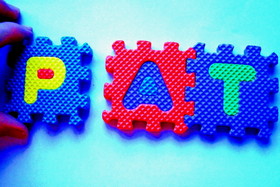Phonics Word Families
Help to Read and Spell Efficiently
Phonics word families are groups of words that have similar letter patterns. By learning just one pattern your child can learn many words at the same time.
When two vowels are placed side-by-side, in most cases the first vowel says its name and the other is silent. Take for example the word rain. Notice that the a in rain says its name and the second vowel i is silent.
Here is a great way to teach this basic phonics rule to a child.
Word Family Examples
Here is a word family your child will learn as an early reader.
cat mat sat fat rat bat hat pat vat
All of these words have the letters at in common. When we read the words aloud the second part of each word sounds and looks the same . This makes them rhyme. In the at family the words are identical, except for the first letter. This is one of the first phonics word families children learn.
The following word family is more complex and would be taught at a much later stage in a child's reading and spelling. The part that is repeated in this family of words is ain.
train gain refrain obtain main remain explain rain brain drain grain stain
Follow This Sequence of Phonics Word Families
There are many different patterns or word families in the English language. The good news is that patterns are recyclable! That means that if your child learns a particular pattern once, they will be able to learn all the other words in that phonics word family without stress. It speeds up the process of learning to read and write.
This is how I, as a literacy teacher, teach the stages. I introduce my students to simple phonics word families in this order...
1. am family
Words like...
ham Sam ram bam dam jam Pam yam
I choose this family first because the letters a and m are among the first letters children should be taught to blend together. They are the easiest for beginner readers to learn.

2. at family
Words like those mentioned above...
cat mat sat fat rat bat hat pat vat
You probably have memories of reading books about cats on mats. Again this is because the t sound is learned early as so many words contain it.
3. an family
Words like...
can, Dan, fan, man, pan, ran, van
4. ad family
Words like...
bad dad had lad mad pad sad
All these words have what we call a short vowel a in the middle of them. The short a sounds like the way we say aaa at the beginning of the word apple.
Once your child understands what paticular sounds the letters make and how to form the letters they will be able to spell them as well as read them. It all depends on how well they can use a pencil but if their pencil grip is good they can sound out the letters and spell them not long after they learn to read them.
I focus on the vowel e when I teach the next group of phonics word families.
5. et family
Words like...
bet get jet let met net pet set vet wet
6. ed family
Words like...
bed, fed, led, Ted, Jed
7. en family
Words like...
Ben, den, hen, Jen, men, pen, ten
You will be getting the idea by now. Notice that at the early stages the words should only contain three letters. For young readers that is plenty to concentrate on.
Next you move to words with other vowels like...
i then o then u.
For a full list of words using these other vowels, click on the link
Once your child has learned to smoothly blend the first few word families they will understand what to do as they work their way through the different vowels.
Learn these word patterns and the more advanced ones and it will make reading and writing much easier.
Go From Phonics Word Families to Phonics Literacy Home Page




